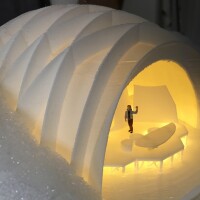An Illustrated History of Aviation in Southern California (Part I)


Relive the excitement of man’s first steps on the moon and the long journey it took to get there with 20 new hours of out of this world programming on KCET's “Summer of Space" Watch out for “American Experience: Chasing the Moon” and a KCET-exclusive first look at "Blue Sky Metropolis," four one-hour episodes that examine Southern California’s role in the history of aviation and aerospace.
Southern California has played a major role throughout the history of aerospace in the United States and the world. Much of its early involvement was shrouded in secrecy in the name of national security. After all, Californians built the planes that won wars. They also built the planes that started wars. The region has hosted some of the biggest events in aviation and has been a hotbed of innovation in space travel since the industry’s birth. Its abundant blue skies hold aloft the American dream. We look back at some milestones from the advent of the airplane through the Second World War.

Trace the evolution of civilian and military aviation and examine the extraordinary mobilization during World War II, considered the greatest industrial achievement in history on "Blue Sky Metropolis" S1 E1: Wings - Aviation Takes Flight in Early Los Angeles


1900 Los Angeles population at 100,000
1903 Wright brothers’ first flight at Kitty Hawk
1910 Los Angeles Air Meet at Dominguez Field advertises $70,000 in prizes money and draws 250,000 spectators. The Los Angeles Times call is “one of the greatest public events in the history of the West.”
1915 World War I begins. Forward-firing machine guns enable aerial combat.
1916 Loughead* brothers set up an airplane firm in Santa Barbara. Using what is essentially a ten-seat flying boat, the brothers give passengers joyrides to nearby cities and islands. *Loughead becomes Lockheed in 1926
1920 Donald Douglas starts aircraft firm in Santa Monica
1923 “Wings” wins first Academy Award for Best Picture. The film sets the bar for aviation films because of its realistic air combat sequences.
1929 The Women’s Air Derby has aviatrices racing from Santa Monica to Cleveland. This is the first event of its kind exclusively for women. Louise Thaden, rival to Amelia Earhart, wins the race.
1929 The stock market crash signals the starts of the Great Depression.
1930 Caltech forms an aeronautical lab.
1932 Jack Northrop starts aircraft company.
1935 North American Aviation moves from East Coast to Los Angeles.
1936 Douglas DC-3 enters service. It sets the standard for modern passenger planes.
1937 Amelia Earhart disappears over the Pacific Ocean.
1940 Los Angeles population at 1.5 million
1941 Workers strike at North American Aviation. FDR threatens to seize the plant if production doesn’t continue because it is clear the U.S. will join WWII.
1941 U.S. enters World War II.
1942 FDR asks for 125,000 planes a year. More than 30,000 planes are produced during wartime, compared to 921 in 1939.
1943 Jet Propulsion Laboratory forms at Caltech.
1945 The United States detonates the first atomic bomb.
1945 World War II ends; aircraft industry demobilizes.
1946 RAND produces first report on “earth-circling spaceship.” Support for the project is low because the idea is deemed by some as “an unholy defiance of God’s will for mankind.”See the next timeline. Click
here.





